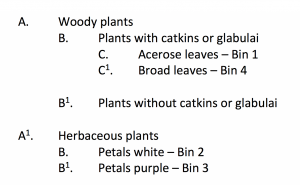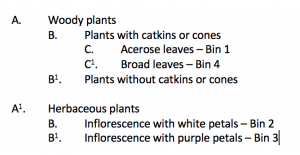Good evening:
The dichotomous key I created to classify the species displayed in Bins 1-4 is embedded within this posting. Thanks!

Here’s the second version with edits & corrections. – ELMV


Good evening:
The dichotomous key I created to classify the species displayed in Bins 1-4 is embedded within this posting. Thanks!

Here’s the second version with edits & corrections. – ELMV

I think I’m finally getting it after looking at your example. I remember you and Lisa talking about “keying out” plants, but didn’t do any practicing during the field study, like I should have done. I really do love learning this science and how to speak the language. Thanks for helping to interpret dichotomous keys.
yes, i agree with Rachel! it’s nice to see examples. i went way too far w/mine! ha!
Yes,
this one works. Not sure what glabulai are?
I looked up botanical terms for cone and, now looking at it again, used an incorrect term and spelled it worng. I added an extra “a” in the plural form of glabulus (glablulus – singlar, glabuli – plural: a fleshy cone).
Hm, I can’t seem to add media to comments. I recreated the dichotomous key with the corrections and was going to insert it in here. Perhaps I’ll be able to add it to my original post.
Thanks, I got it! Thanks for your explanation. The revised key works well!
It was very helpful to look at your D. Keys! Thanks! Glad to see you are in this class!